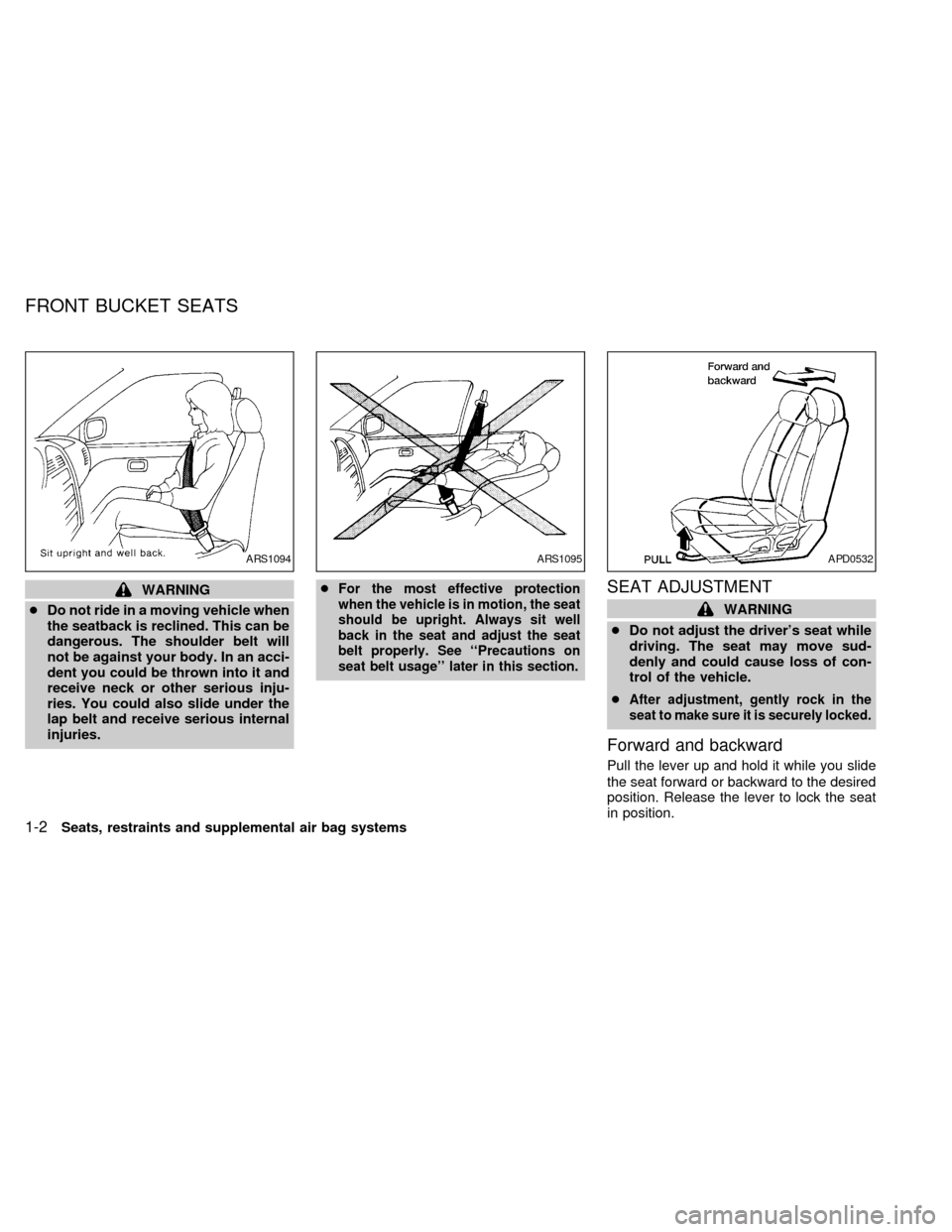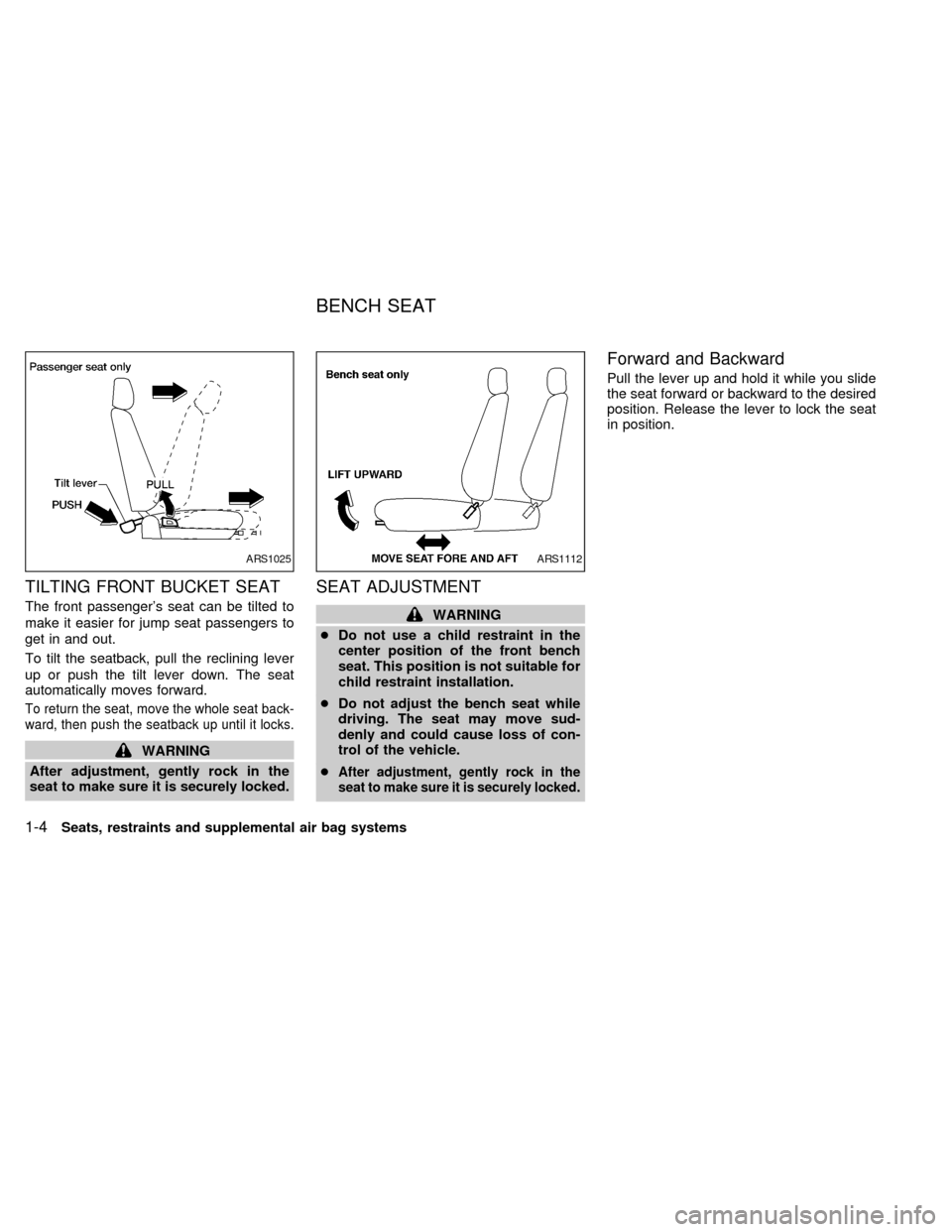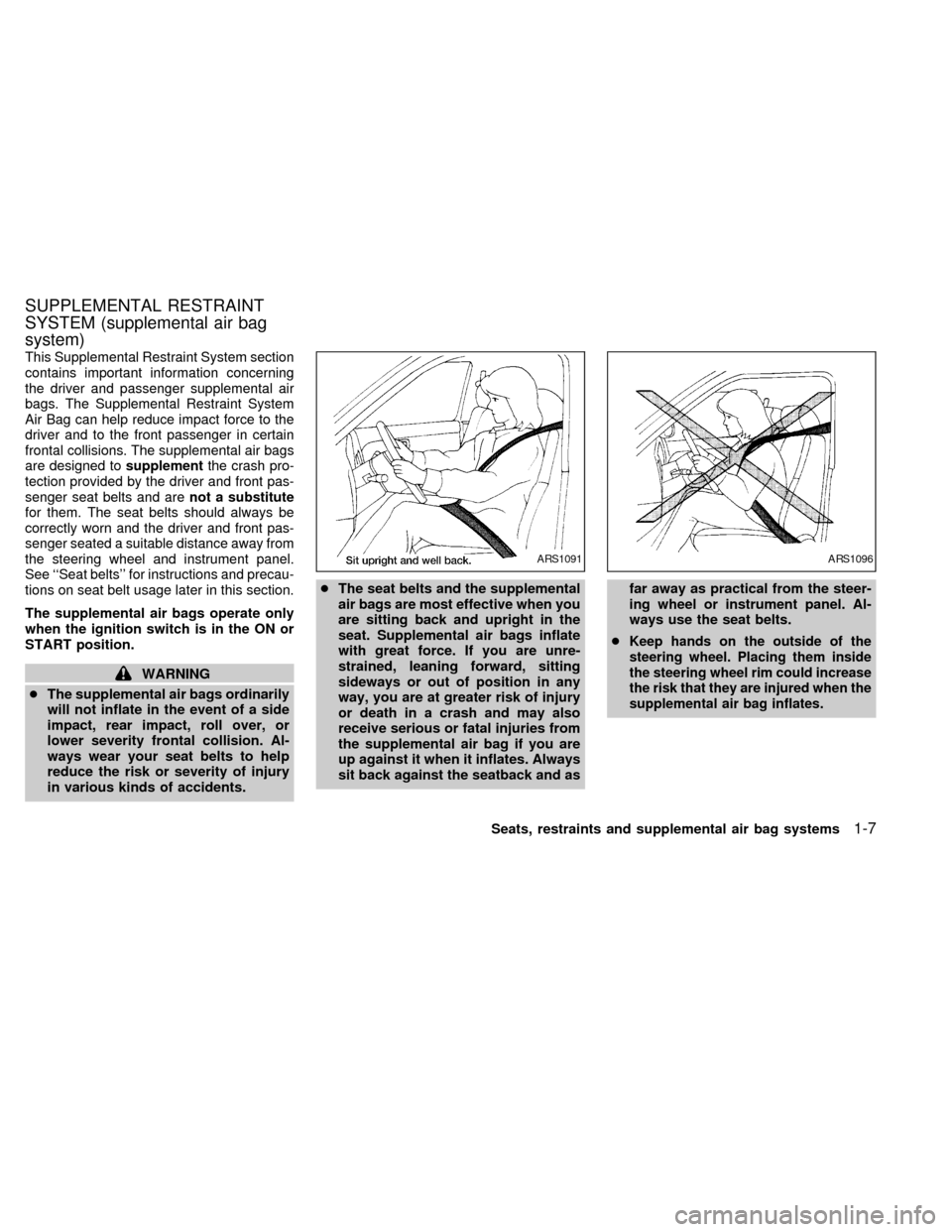Page 6 of 224
Table of
ContentsSeats, restraints and supplemental air bag systems
Instruments and controls
Pre-driving checks and adjustments
Heater, air conditioner and audio systems
Starting and driving
In case of emergency
Appearance and care
Do-it-yourself
Maintenance
Technical and consumer information
Index
1
2
3
4
5
6
7
8
9
10
11
Page 8 of 224

1 Seats, restraints and supplemental air
bag systems
Front bucket seats..................................................1-2
Seat adjustment .....................................................1-2
Head restraints .......................................................1-3
Tilting front bucket seat ..........................................1-4
Bench seat .............................................................1-4
Seat adjustment .....................................................1-4
Tilting bench seat ...................................................1-5
Jump seats .............................................................1-6
Supplemental restraint system (supplemental
air bag system).......................................................1-7
Supplemental air bag system...............................1-10
Passenger supplemental air bag on/off switch
and light. ...............................................................1-12
Warning labels......................................................1-15
Supplemental air bag warning light......................1-15
Seat belts .............................................................1-17Precautions on seat belt usage ...........................1-17
Child safety...........................................................1-18
Pregnant women ..................................................1-19
Injured persons ....................................................1-19
Three-point type with retractor .............................1-20
Two-point type without retractor (jump seat
and center of bench seat) ....................................1-22
Seat belt extenders ..............................................1-25
Seat belt maintenance .........................................1-25
Child restraints .....................................................1-25
Front facing installation on front passenger
seat (three-point type with retractor) ....................1-27
Rear facing installation on front passenger
seat (three-point type with retractor) ....................1-30
Top strap child restraint .......................................1-33
ZX
Page 9 of 224

WARNING
cDo not ride in a moving vehicle when
the seatback is reclined. This can be
dangerous. The shoulder belt will
not be against your body. In an acci-
dent you could be thrown into it and
receive neck or other serious inju-
ries. You could also slide under the
lap belt and receive serious internal
injuries.cFor the most effective protection
when the vehicle is in motion, the seat
should be upright. Always sit well
back in the seat and adjust the seat
belt properly. See ``Precautions on
seat belt usage'' later in this section.SEAT ADJUSTMENT
WARNING
cDo not adjust the driver's seat while
driving. The seat may move sud-
denly and could cause loss of con-
trol of the vehicle.
c
After adjustment, gently rock in the
seat to make sure it is securely locked.
Forward and backward
Pull the lever up and hold it while you slide
the seat forward or backward to the desired
position. Release the lever to lock the seat
in position.
ARS1094ARS1095APD0532
FRONT BUCKET SEATS
1-2Seats, restraints and supplemental air bag systems
ZX
Page 10 of 224
Reclining
To recline the seatback pull the lever up and
lean back. To bring the seatback forward,
pull the lever up and lean your body forward.
The seatback moves forward. Release the
lever to lock the seatback in position.
HEAD RESTRAINTS
Adjust the head restraint so the top is level
with the tops of your ears.
To raise the head restraint, pull it up. To
lower, push the lock knob while pushing the
head restraint down.
WARNING
Head restraints should be adjusted
properly as they may provide significant
protection against injury in an accident.
Do not remove them. Check the adjust-
ment after someone else uses the seat.
NOTE:
The head restraints on the bench-type
seats are not adjustable.
APD0531MPA0001
Seats, restraints and supplemental air bag systems1-3
ZX
Page 11 of 224

TILTING FRONT BUCKET SEAT
The front passenger's seat can be tilted to
make it easier for jump seat passengers to
get in and out.
To tilt the seatback, pull the reclining lever
up or push the tilt lever down. The seat
automatically moves forward.
To return the seat, move the whole seat back-
ward, then push the seatback up until it locks.
WARNING
After adjustment, gently rock in the
seat to make sure it is securely locked.
SEAT ADJUSTMENT
WARNING
cDo not use a child restraint in the
center position of the front bench
seat. This position is not suitable for
child restraint installation.
cDo not adjust the bench seat while
driving. The seat may move sud-
denly and could cause loss of con-
trol of the vehicle.
c
After adjustment, gently rock in the
seat to make sure it is securely locked.
Forward and Backward
Pull the lever up and hold it while you slide
the seat forward or backward to the desired
position. Release the lever to lock the seat
in position.
ARS1025ARS1112
BENCH SEAT
1-4Seats, restraints and supplemental air bag systems
ZX
Page 12 of 224
TILTING BENCH SEAT
The bench seat can be tilted forward to
make it easier to remove the jacking tools
from the storage area.
To tilt the seatback, push the tilting leverdown, then pull the seatback forward.
WARNING
After adjustment, gently rock in the
seat to make sure it is securely locked.
APD0703
Seats, restraints and supplemental air bag systems1-5
ZX
Page 13 of 224
WARNING
cDo not install a child restraint in the
jump seats (King Cab model). These
seats are not suitable for child re-
straint installation.
c
When folding the jump seat, be careful
not to squeeze your finger between
the seat cushion and the body side.
ARS1026
JUMP SEATS
1-6Seats, restraints and supplemental air bag systems
ZX
Page 14 of 224

This Supplemental Restraint System section
contains important information concerning
the driver and passenger supplemental air
bags. The Supplemental Restraint System
Air Bag can help reduce impact force to the
driver and to the front passenger in certain
frontal collisions. The supplemental air bags
are designed tosupplementthe crash pro-
tection provided by the driver and front pas-
senger seat belts and arenot a substitute
for them. The seat belts should always be
correctly worn and the driver and front pas-
senger seated a suitable distance away from
the steering wheel and instrument panel.
See ``Seat belts'' for instructions and precau-
tions on seat belt usage later in this section.
The supplemental air bags operate only
when the ignition switch is in the ON or
START position.
WARNING
cThe supplemental air bags ordinarily
will not inflate in the event of a side
impact, rear impact, roll over, or
lower severity frontal collision. Al-
ways wear your seat belts to help
reduce the risk or severity of injury
in various kinds of accidents.cThe seat belts and the supplemental
air bags are most effective when you
are sitting back and upright in the
seat. Supplemental air bags inflate
with great force. If you are unre-
strained, leaning forward, sitting
sideways or out of position in any
way, you are at greater risk of injury
or death in a crash and may also
receive serious or fatal injuries from
the supplemental air bag if you are
up against it when it inflates. Always
sit back against the seatback and asfar away as practical from the steer-
ing wheel or instrument panel. Al-
ways use the seat belts.
c
Keep hands on the outside of the
steering wheel. Placing them inside
the steering wheel rim could increase
the risk that they are injured when the
supplemental air bag inflates.
ARS1091ARS1096
SUPPLEMENTAL RESTRAINT
SYSTEM (supplemental air bag
system)
Seats, restraints and supplemental air bag systems1-7
ZX